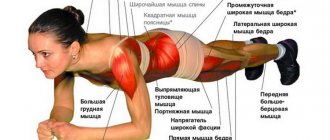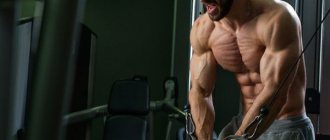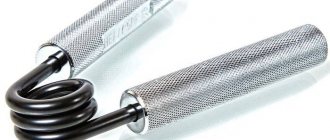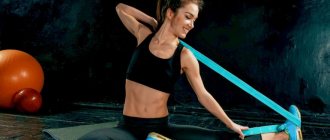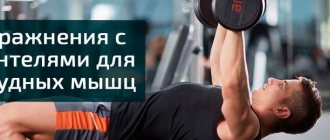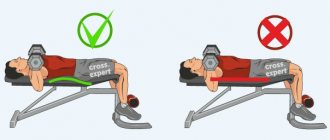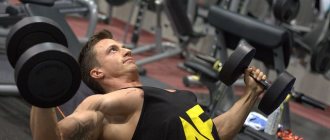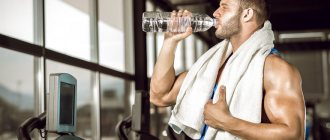In the development of muscles, training the muscles of the forearm plays an important role and requires special attitude, organization and attention. The fact is that they are not so easy to pump up, unlike, for example, biceps or chest muscles. To achieve results - high-quality strengthening and increase in volume - you need a well-designed set of special exercises. This material will discuss issues related to how to pump up your forearms , including a home training .
In order for an athlete’s body to look proportionally developed, working out these muscles is mandatory, despite the fact that they belong to the “small” category and are not so noticeable compared to the pectoral, shoulder and quadriceps muscles. It is also impossible to fully and harmoniously develop other muscle groups without strengthening the forearms: insufficient training of the forearm significantly complicates the task of achieving progress in training.
Why is such training necessary?
In terms of appearance, developed forearms play an important role, providing the impression of massiveness, power, and physical strength. Also visually the body looks symmetrical (naturally, if other muscle groups are pumped up).
We should not forget about the impression on others that bodybuilders make in clothes, since in most cases it is the forearms and neck that are exposed. And this can be called a compelling argument, since a person with an ideal body in any society feels more confident and comfortable than others.
According to experts, regular training of this muscle group is also necessary from a safety point of view, since it minimizes the risk of injury during complex complexes. This applies, for example, to an exercise for the back such as pull-ups with additional weight, where you need a good grip, the strength and strength of which depends on the muscles of the forearm. This is a difficult exercise and, like any other with heavy weight, can only be performed with strong arms.
How to pump up your forearms on the horizontal bar
There are many exercises available in the gym to pump up your forearms, but not everyone knows how to pump up your forearms by training on the horizontal bar. Using a horizontal bar during pull-ups, you can force your forearms to work a little by choosing an appropriate, for example, narrow grip.
Close grip pull-ups
But the most effective is hanging on a horizontal bar using various techniques and with weights. The hands have to hold on to the bar, the muscles of the forearms are in constant static tension, which leads to their pumping. Let's consider several variations:
- Hanging on the horizontal bar, doing a “roll up and roll up” grip
- Isometric hang variation
- Hanging with a bar extender
We recommend watching Yuri Spasokukotsky’s recommendations in more detail in his video.
Taking sports supplements - creatine, arginine, intra-workout, bcaa amino acid and pre-workout complexes will also help you increase your strength.
These sports nutrition products are specifically formulated to improve performance in sports and fitness for men and women. Just add it to your diet and go ahead to conquer new heights!
Anatomy
The forearm is the part of the arms from the elbow to the hand. The muscle group consists of:
- brachial muscle - brachialis;
- flexors;
- pronator teres;
- brachioradialis muscle – brachioradialis;
- extensors.
These muscles are classified as “small” and are responsible for rotation, flexion/extension of the arms at the wrist and elbow joints. The complex anatomical structure further complicates the task of pumping up the forearm. During the exercise, all the muscles of this anatomical group, of which there are only five, should be involved.
Questions about the training[edit | edit code]
Seated Wrist Curls
YOUR QUESTION:
Do you need to target your forearms? I do at least 16 biceps sets per week. Perhaps this is enough to develop grip strength?
ANSWER:
In fact, holding weights while doing biceps curls puts a lot of stress on your forearms. So, your grip strength will increase as your training equipment increases. However, we are talking about a static load, which does not bring progress in volumes.
To increase the mass of your forearms, you should do dynamic wrist curls at the end of your arm muscle training. At first, do this exercise while sitting. Well, when you reach a solid weight, move on to the advanced standing version. The exercise is similar to a behind-the-back barbell shrug, but you need to lift the bar, not your shoulders, by bending both wrists. Start mastering the exercise in the Smith machine. Do 4-8 sets immediately after biceps exercises.
YOUR QUESTION:
Is it necessary to pump up the front deltoids separately?
ANSWER:
In fact, the front deltoids already receive enough load when performing heavy bench presses. Attempts to add a couple of targeted movements for these beams into the training program usually lead to overtraining. However, these days, many beginners suffer from a congenital lack of mass in the deltoid muscles and especially their anterior bundles. This feature of the build can become a serious obstacle when mastering all types of “chest” presses. If your working weights in such presses refuse to grow, add 1-2 targeted exercises for the anterior bundles to your delta training. Do them for 3 weeks in a row, then take a week break. If your bench press results have improved, you are on the right track.
Super advice
Gunar Peterson
Unfortunately, weak forearms are a bottleneck for many amateurs. Some people simply do not know that a weak grip reduces the working weight in biceps exercises. Conversely, the more you grip the bar, the more weight you can lift. I advise my students to target their forearms on leg day. Since you are not bothered by arm fatigue, you will be able to complete at least 12-15 sets.
Useful information and recommendations
The “stubborn” muscles their name because of their high resistance to stress. This is due to the fact that they are involved not only in everyday life, but also in the process of training other muscle groups. Therefore, developing the forearm is a labor-intensive task that requires persistence, regular training and a lot of patience.
First of all, you need to determine the number of classes per week: two workouts will be enough to harmoniously develop the muscles of the forearm. Each element of the complex is performed in three approaches, each repeated 10-15 times . It is important not to forget about warming up and warming up before training, since the likelihood of injury is high. Also, avoid overstretching the muscles at the peak range of motion.
The best option is to combine exercises for pumping up the forearm with a training complex for the back and arms. But they should be performed at the end of the program, after working out the muscle groups of the back and arms, otherwise the training will not be effective.
It is not recommended to conduct more than two sessions weekly, since the minimum period for recovery of this muscle group is two days, the best option is three days. With regular overstrain of the forearm, the risk of chronic pain in the wrist area increases.
What will you get if you decide to pump up your forearms?
While they complement your look, they will also help you develop strength and functionality when lifting weights, and will later help you build mass in other areas such as your back, shoulders and biceps.
The forearms are indeed stimulated through lifting movements such as bending, lifting, and chin-ups/pulldowns, but in order for an athlete to reach their full potential and build strength in their forearms (especially if they are a weak point), they must incorporate specific training into their program .
However, this does not mean that you need to do one or two movements at the end of your arm training day and perform the exercises at minimal intensity.
Can't wait to start training your forearms? We have prepared for you a basic advanced program that is suitable for all levels of training. Take it on a separate day of training or combine it with back/leg training.
Working with a barbell
Exercise No. 1 . Reverse grip barbell curl
Performed in a standing position, similar to biceps training, but with a reverse grip. The bar rises to the level of the shoulders, which must remain motionless. Then it goes down smoothly. In this case, the rise is done while exhaling, returning to the starting position is while inhaling. Unlike the biceps exercise, in this case a barbell with a lighter weight is used, since the brachyradialis is weaker, and it bears the main load.
Exercise No. 2. Seated Wrist Curl
Performed in a sitting position. The barbell is grasped with an underhand grip and the forearms are lowered onto the hips. The projectile goes down, while the bar must be held firmly, and the forearms must be slightly extended forward. After this, the arms begin to work: slow flexion and extension at the wrists with a low amplitude. It is important that the movements are smooth, without jerking or swinging the barbell to avoid injuries and sprains.
Exercise No. 3. Standing behind-the-back wrist curl
Performed in a standing position, the barbell is behind the back. In this case, the palms are turned back. Take a barbell and perform flexion-extension of the arms at the wrists without the participation of the elbow joints. The exercise allows you to develop the muscles of the wrist. If exercise No. 2 causes certain difficulties when performing, you can use this option.
Denis Semenikhin. Forearm workout
Working on your grip strength
There are many ways to improve your grip to increase the strength and mass of your forearms. Grip exercises, no straps for certain back exercises, and the use of plates are just a few methods for better forearm development. One of the most effective and convenient techniques is to firmly grip the bar at the end of all sets of wrist curls.
After each set of curls, raise the weight to a contracted position and hold the bar for 5-10 seconds. This will be difficult to do after a regular set, but this exercise will improve your grip strength and add intensity to your forearm training program.
We also recommend that you familiarize yourself with exercises with a kettlebell from Victor Blud to develop a strong grip.
This complex of 3-5 approaches can also be done at home.
Work with dumbbells
"Zottman Curls"
It is a mandatory component of a training complex with dumbbells for this muscle group. This is one of the options for working with a barbell on the forearms, only dumbbells are used instead of this apparatus. The latter are held in the lower position (like a hammer); during the upward movement, the forearm is pronated (turning the palms down). Then the projectiles are lowered in the reverse order of movements.
Seated Wrist Curl
Another exercise - bending the arms in a sitting position - is performed like a similar training with a barbell, but with dumbbells. Also, training each arm in turn in a sitting position with dumbbells will be effective.
The best exercises for training your forearms
The best exercises for creating beautiful forearms are:
- Lifting the barbell onto the biceps with a reverse grip (works: forearm extensors + brachioradialis muscle). As we remember, the brachioradialis muscle is the BIGGEST muscle in our forearms.
- Forearm curls with a barbell/dumbbells, sitting on a bench (work: ulnar and radial flexors).
- Pronation (turning inward) of the hand with a one-sided dumbbell or strap (work: two pronators of the hand).
These exercises are the BASIC ones for shaping your forearms, but there are a few additional exercises (variety, but less effect).
- Hammer curls for biceps.
- Supination of the hand with a dumbbell or strap (turning the hand outward).
- Various static weight-bearing exercises + expanders.
- Forearm extensions with a reverse grip while sitting on a bench.
Working with an expander
A super-hard expander is used, exercise with which is a good alternative for regular home workouts to develop this muscle group. A soft projectile is used mainly for working on the hand, so in this case it is important that it be hard. It is also recommended that you consult with your retailer regarding the most suitable resistance band to use in forearm training.
Reverse Grip Wrist Curl
For anyone who doesn’t know how to pump up their forearms, we advise you to rely on bending your wrists with a reverse grip. The exercise is practically no different from the above method. The only difference is gripping the bar of the sports equipment from below when the palms are facing up. The main load in this case falls on the extensor muscles of the forearms.
Hold dumbbells or a barbell over the edge of your bent knees. Allow the load to pull on the extensor muscles. Then move your wrists in the opposite direction, squeezing the bar. Achieve maximum muscle contraction.
Additional program elements
- Jumping with weights on a skipping rope. During this 20-minute training, the outer surface of the forearm area is well worked out.
- Working with a punching bag - punches. The use of weighted gloves is also recommended as these exercises provide excellent flexor work.
- Using a special rubber bracelet during training. Allows you to increase muscle resistance, promotes strengthening and development of mass.
In conclusion, one more recommendation: you should not give up hard work around the house, even with regular exercise. Working with tools (drill, hammer, etc.), moving heavy furniture is an excellent way to work the muscles of the forearms.
Igor April 15, 2016
Strengthening the forearm muscles: recommendations
- Exercises for the forearm are performed last, after working on the biceps and triceps.
- In order to pump up the muscles of the forearm, you should use a weight that is approximately 70% of 1 RM.
- You need to train your forearms using a scheme consisting of sets and repetitions. The optimal number of sets will range from 2 to 4 depending on the athlete’s physical fitness and 8-14 repetitions. To develop small muscles, such as the muscles of the forearm, it is important to use moderate weight and a higher number of repetitions.
- It is very important to monitor the proportions. The volume of the forearm should not be greater than the volume of the biceps.
- You should not take long breaks between exercises on the target muscle group. 30-40 seconds of rest is enough.
The forearm muscles can be trained twice a week, but then the second workout will be aimed at developing grip strength. To do this, use wrist expanders and squeeze with your fingers.
And also read: Exercises for stretching the forearm → How to pump up arm muscles at home → Exercises with an elastic band for the arms →
Winding a rope with a suspended load onto a crossbar
There is another original technique that will help you figure out how to pump up your forearms. We are talking about winding a rope with a load. The workout tightens a wide range of small muscles in the target area. As equipment you should use a straight stick and a weight in the form of a pancake from a barbell. Tie the weight to the end of a strong thin rope. Fix the second end securely on the stick.
Take a vertical stance. Grab the previously prepared crossbar with both hands from opposite edges. Hang the weight on a rope above the floor surface. Place your upper limbs in front of you parallel to the ground. Place your feet at shoulder level for stability. Alternately perform movements with your hands, winding a rope with a suspended weight around a stick. When the load reaches its highest point, slowly unwind the device back. Perform several cycles. Then rest for a couple of minutes and repeat the above steps again.
Static load holding
Another way to pump up your forearms? A good solution would be to keep the discs hanging from the barbell. Performing the exercise promotes the progressive development of local muscle strength. Achieving impressive volumes in this case is quite difficult. However, your grip will improve noticeably. In the future, it will be much easier to hold the bar of heavy sports equipment.
The essence of the training is as follows. Grab the plates from the bar with your fingers, holding the devices by the edges. Next, you will have to stand in a static position for the maximum possible amount of time. Hold discs of identical weight in each hand to distribute the load evenly on both limbs. First, use pancakes weighing about 20-25 kg. Gradually increase the weight of the projectiles over time.
Before you start training
Despite the fact that the exercise is relatively simple, pay attention to a number of contraindications to its implementation.
- If your elbows hurt, it is not recommended to do the exercise until the acute pain syndrome passes. It is advisable to do an MRI of the elbow joint to clarify the etiology (origin) of pain.
- If your wrists hurt, you should also let them recover. You can try using a medium-hard hand brace. If you do extensions with them painlessly, train calmly.
- After fractures, you need to wait a few weeks after removing the cast and start doing extensions with small weights. This will help restore ligaments and tendons that have become unaccustomed to stress and prepare the joint for further weights.
Exercise "Hammers"
The workout is similar to lifting dumbbells in a vertical biceps rack. The difference is the special position of the hands when sports equipment is located in a vertical plane. The body movements in this case are somewhat reminiscent of blows with hammers.
How to pump up the muscles of the forearms? The technique is as follows. Grasp the dumbbells firmly with your hands and rotate the implements so that your palms are facing each other. Place your feet shoulder-width apart, straighten your back, and look ahead. Press your elbows lightly toward your body. Exhale and slowly move the dumbbells to your shoulders. Stay in a static position for a couple of seconds, then return to the starting position, straightening your limbs. The main load will fall on the biceps. However, due to the vertical position of the dumbbells, the forearms will receive considerable stress.
A set of exercises for arms without dumbbells
Standard push-ups
- Take a lying position.
- Place your palms under your shoulders or slightly wider than them.
- Your elbows should point toward your body, not away from it.
- Go down and up as much as possible to the full amplitude.
In most push-up variations, the triceps do the most work, while the rest only stabilize the core, helping other muscles contract. You can change the load by changing the distance between your hands, but remember that this also changes the main working muscles. Learn more about how to do push-ups →
The distance between the hands also plays a big role. If you do push-ups with a wide grip, then the chest works more, if with a narrow grip, then the triceps.
Reverse push-ups
- Walk to a surface that is slightly higher than your knees.
- Sit on the floor with your back to the conditional simulator and place your hands on it.
- Relax your lower part and lift yourself up with your arms.
Reverse push-ups train the triceps well and stretch the lateral chest muscles. To increase the load on the muscles, you can place your legs on some kind of elevation to increase the range of motion. You can also move your body away from the surface to press diagonally to the top point.
Reverse Grip Push-Up
- Take a lying position.
- Turn your palms with your fingers towards your feet.
- Lower your hands to the level where your ribs end.
This exercise is suitable if you want to pump up your biceps. The bottom line is that it primarily acts as a stabilizer rather than as a main force.
The difficulty arises in lowering the palms closer to the pelvis. Do not try to immediately move them away from you, otherwise you risk not only not completing these exercises, but also injuring your joints.
Increase the range gradually. Keep an eye on your technique. With such push-ups, the biceps, as the main stabilizer, ceases to fulfill its role and therefore you will sway and arch heavily. However, this is one of the best ways to build this muscle without using dumbbells and other sports equipment.
Rhino push-up
- Take a lying position.
- Lift your pelvis up into triangle pose.
- Perform the press diagonally downwards, touching your head to the floor.
This exercise targets the shoulders the most.
- Try to balance less with your pelvis; you should shift the entire load to your arms.
- To increase the difficulty of the execution , create a smaller angle by moving your hands to your feet, or raise your legs to a higher elevation.
Read more about house push-ups →
Reverse grip pull-up
- Grab the horizontal bar with a reverse grip, with your fingers facing you slightly wider than your shoulders.
- Rise strictly under the horizontal bar, without deviating.
- Don't go all the way down.
This will work your biceps. You should not lean away from the bar or lower yourself completely, as with these movements we force our back to take the load.
Read more about biceps pull-ups →
Standard pull-ups
- Grab the horizontal bar with an overhand grip, with your fingers facing away from you.
- Pull yourself up so your chin clears the bar.
- Lower yourself, straightening your arms completely.
In this case, the back is most involved, but also the forearms . When you go down, do not relax your back, keep it always tense. You can use a close grip to use your forearms more.
Read more about pull-ups on the horizontal bar →
Precautionary measures
If you don't know where to start or want more precise recommendations, consult a fitness trainer. A specialist will help solve any problems, create a personal training program and monitor how you do the exercises.
Train at loads that suit you well. Be careful, control your breathing accompanying your movements. Avoid sudden movements.
Stop if you feel pain or discomfort. If you feel pain after exercising, apply ice to the sore area and try gentle stretching to relieve tension.
If you have any injuries or medical conditions, it is best to train under the guidance of a doctor or physical therapist.
Using strength training equipment
Anchor point behind your back
- Take a few steps away from the machine and turn your back to it.
- Grasp the handle of the loop attached to the bottom with your left hand, placing your right foot slightly in front of your left.
- Slowly bend your arm and lift it towards your shoulder.
- Pause before lowering your arm to the starting position.
Grabbing the sling with a towel
- Attach the towel to the loop handle.
- Grasp the edges of the towel.
- Squeeze your shoulder blades together and pull the towel towards your chest.

